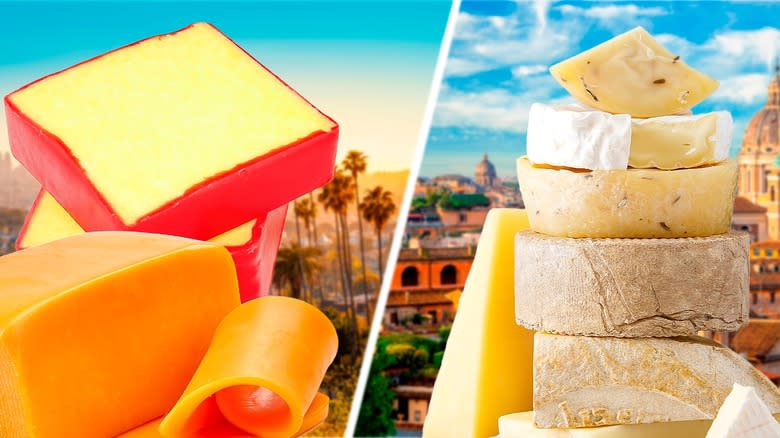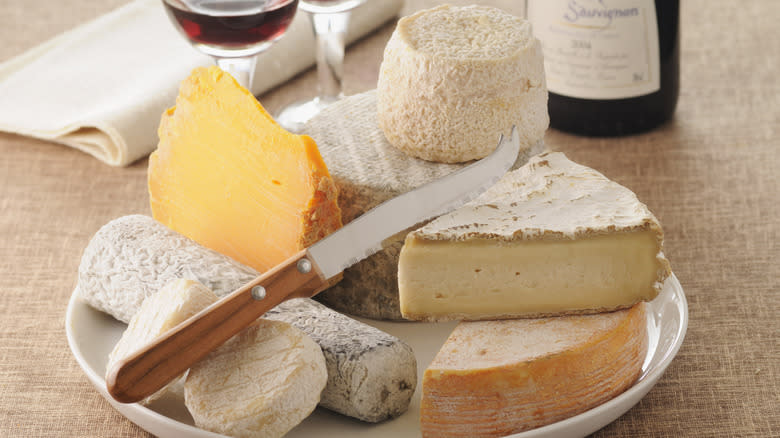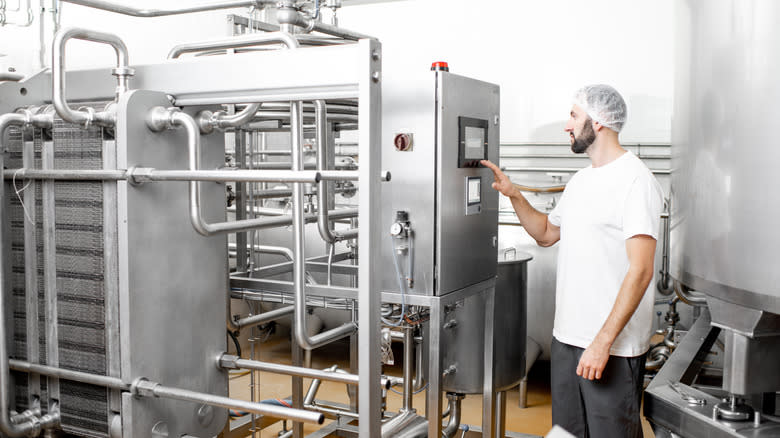The Big Differences Between American Cheese Varieties And European

When it comes to cheese, American and European varieties stand as distinct expressions of culinary craftsmanship. The two vast geographical locations have each cultivated their own rich cheese-making traditions, yielding products with unique characteristics and flavors. But unless you're a cheesemonger, cheese just might seem like cheese, particularly when you're wandering the grocery store looking for cheese board ingredients. Let's take a deep dive into the complex -- and sometimes contentious -- worlds of American and European cheese.
In general, American cheeses are often crafted through industrial processes, using advanced technologies to ensure consistency and affordability. In contrast, European cheeses often adhere to time-honored, artisanal methods, prioritizing tradition and terroir. However, the differences extend beyond production methods; ingredients also play a pivotal role. American cheeses may incorporate additives and stabilizers for longer shelf life, while European counterparts typically rely on simpler, more natural components. One cannot overlook the contrast in cost, either. European cheeses, cherished for their nuance, geographical indications, and history, often come with a premium price tag in American markets.
It's important to dispel the misconception that one is inherently superior to the other. Both American and European cheeses offer a diverse array of tastes, textures, and applications, each with its own merits. There are good and bad examples in both places. So, whether you're savoring a creamy French brie or relishing the sharp bite of a Vermont cheddar, there is plenty to appreciate. Let's explore what each place brings to the world of cheese.
Read more: The 20 Best Olive Oils For Cooking
How Is American Cheese Different From European?

American cheeses, a diverse and vibrant category in the culinary world, have carved their own distinct niche on the global cheese landscape. While Europe often takes the spotlight in cheese discussions, American cheeses offer a delightful spectrum of flavors, textures, and traditions that are uniquely their own. The origins of American cheese-making trace back to the early days of European colonization, with immigrants bringing their cheese-making traditions to the New World. Over centuries, American cheese artisans have harnessed their creativity, blending old-world techniques with modern innovation.
What sets American cheeses apart is their willingness to embrace variety and experimentation. From the iconic American slices to the nutty, Alpine-inspired wheels of Wisconsin gruyere, American cheesemakers have adapted and expanded upon classic European styles. While American cheeses may share some similarities with their European counterparts, they often reflect local flavor profiles. Furthermore, American artisanal cheesemakers are not bound by centuries-old regulations, allowing for more innovation and creative liberty in cheese production.
In recent years, the American cheese scene has seen an exciting resurgence, with a growing number of small-scale producers crafting artisanal cheeses that rival their European counterparts in complexity and quality. So, whether you're exploring a tangy blue cheese from Oregon, a creamy goat cheese from California, or a sharp aged cheddar from New York, American cheeses are a testament to the country's rich tapestry of flavors, makers, and traditions.
European Cheeses Are Old World

European cheeses embody centuries of artisanal craftsmanship and regional diversity. Europe boasts a rich and storied history of cheese-making that sets its produce apart from those produced elsewhere. With roots dating back thousands of years, European cheeses are deeply intertwined with the continent's culture and geography.
What truly distinguishes European cheeses is their unwavering commitment to old-world techniques and time-honored styles of production. Many of these cheeses are lovingly crafted by hand, often by skilled artisans who have dedicated their lives to perfecting their craft. Traditional methods passed down through generations continue to be the backbone of European cheese-making. Gorgonzola was invented by accident in the 9th century, and has changed very little since then, still being made with penicillium to create the mold. Some cheeses, like those crafted by monastic communities, such as Roquefort, which was mentioned in 11th-century records at Conques, in France, maintain a sense of sacred tradition, echoing the same meticulous practices that monks followed centuries ago.
European cheeses are renowned for their remarkable diversity, shaped by the distinct terroirs and local traditions of each region. From pungent blue-veined Roquefort to nutty, Alpine classics like Emmental from Switzerland, European cheeses captivate the senses with their unique flavors, textures, and aromas. Whether aged in centuries-old caves or mountain chalets, European cheeses remain a testament to the enduring artistry and heritage of cheese-making on the continent.
American Cheese Tends To Be More Processed

American and European cheeses diverge in their production methods, reflecting distinct philosophies and regulatory landscapes. One notable difference lies in pasteurization. American cheeses often undergo pasteurization, a process mandated for safety reasons, which involves heating milk to kill harmful bacteria. Consequently, pasteurization can alter the flavor and texture of cheese, yielding products that lean towards consistency and conformity. Any cheeses that are made with raw milk in the U.S. must be aged for a minimum of 60 days to be sold.
In contrast, many European cheeses are crafted with raw milk, allowing the full spectrum of natural flavors to flourish and develop during the aging process. It's for this reason that many cheeses are not allowed to be brought back to the U.S. from Europe with travelers. So, to truly enjoy raw European cheeses, you'll need to plan a trip.
Packaging also sets these cheeses apart. American cheeses frequently come vacuum-sealed or in plastic wrap, prioritizing convenience and extended shelf life. In contrast, European cheeses often grace the shelves in artisanal markets, presented in wax paper, wooden boxes, or cloth coverings that maintain the cheese's integrity and allow it to breathe.
European Cheeses Are Often Pricier With Good Reason

When it comes to the price disparity between American and European cheeses, one of the primary factors at play is importation. European cheeses often command a premium price tag in American markets due to the costs associated with shipping, tariffs, and import duties. This means that consumers may find themselves shelling out more for their favorite wedges of gruyere or rounds of Camembert than they would for domestic varieties. However, price discrepancies aren't solely attributed to importation.
In both American and European cheese markets, various factors contribute to higher prices. For American cheeses, production costs, such as sourcing high-quality milk, maintaining stringent safety standards, and investing in modern equipment and facilities, can drive up prices. Similarly, in Europe, artisanal cheeses made by hand using traditional methods may come with a higher price tag to account for labor-intensive processes and limited production quantities. Factors like aging time, cheese rarity, and the exclusivity of certain varieties also influence pricing in both markets.
Ultimately, while European cheeses may be more costly due to importation, a myriad of factors contribute to the pricing dynamics of both American and European cheeses, reflecting the intricate interplay between tradition, innovation, and market demand.
Taste And Texture Differs In America And Europe

When comparing American and European cheeses, discerning palates may notice distinct differences in taste and texture that stem from variations in production methods, ingredients, and terroir. Versions of gruyere, for example, share common characteristics. The American adaptation, however, is easily set apart from its European counterpart. This is one reason that Swiss and French gruyere makers tried to restrict Americans from calling their cheese gruyere. However, a court decided in 2023 that Americans could use gruyere as a generic term for American gruyere cheeses.
Cheaper American gruyere tends to be milder in flavor, with a slightly different aftertaste compared to the original. And its texture can lack the same depth and complexity found in the terroir of traditional European gruyere. It also melts differently. While European gruyere boasts a smooth, creamy melt that enhances fondues and gratins, American gruyere doesn't have the same level of meltiness. But, as with many American and European cheeses, there is a huge range of quality of gruyere across the board.
Just keep in mind that there will be differences between the same style of cheese depending on where it originates, and how it is made. The trick is to seek out the best varieties, whether eating American or European cheese. Don't stint, instead opt for the best version of that cheese to get the best flavor and eating experience.
Read the original article on Tasting Table.

